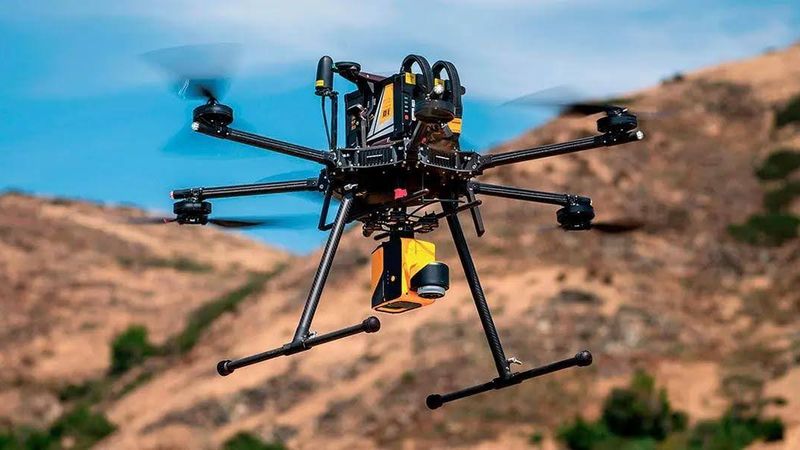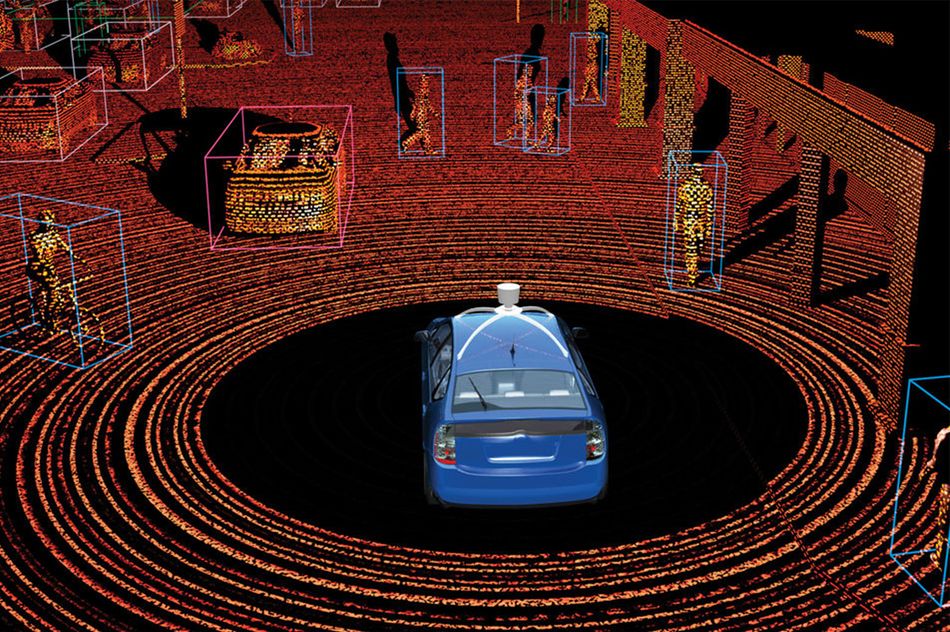The Role of Silicon Photomultipliers in Enhancing Optical Sensing and LiDAR Technology
The Silicon Photomultiplier (SiPM) is transforming optical sensing and LiDAR technology by providing high photon detection efficiency, low noise, and fast response times, enabling greater accuracy and resolution in applications such as autonomous navigation, environmental mapping, and 3D imaging.
This article explores how Hamamatsu's SiPMs significantly enhance LiDAR technology. It focuses on their impact on autonomous vehicles, drone navigation, and 3D mapping while highlighting their role in shaping the future of optical sensing.
Fundamentals of Silicon Photomultipliers (SiPMs)
Operational Principle of SiPM
A Silicon Photomultiplier (SiPM) detects single photons through an array of microcells, each functioning as an avalanche photodiode (APD) in Geiger mode. The device is externally biased above its breakdown voltage (VBRV), with the overvoltage (ΔV=VBIAS−VBR) as the primary control parameter.
When absorbed, a photon generates a charge carrier that triggers an avalanche, producing a current pulse with a high internal gain ranging from 105 to 107. The quenching resistor (RQ) then restores the microcell to its initial state, allowing continuous operation.
The amplitude of the output signal depends on how many microcells are activated. If multiple photons strike different microcells, their pulses combine, resulting in a signal proportional to the number of detected photons. However, if multiple photons enter the same microcell simultaneously, only a single pulse is generated, limiting the linearity of the response. To ensure accurate photon detection, SiPMs require a sufficient number of microcells to match the expected photon flux.
The SiPM gain (μ) is determined by the total charge (Q) transferred per avalanche event, given by:
μ=CJΔVe
where CJ is the junction capacitance and e=1.6×10−19C. The current pulse reaches a peak amplitude (Imax):
Imax=ΔVRQ+RS
where RQ is the quenching resistor, and RS is the APD's series resistance. However, this pulse decays exponentially with a characteristic time constant (τ):
τ=RQCJ
which governs how quickly the SiPM resets for subsequent photon detection. While gain does not explicitly depend on temperature, temperature can affect performance unless ΔV is actively regulated.
Finally, the photon detection is estimated using two methods: pulse height analysis, where distinct pulse levels correspond to single-photon and multi-photon events, and charge integration over time, which reveals discrete peaks based on the number of detected photons.
Although a SiPM consists of an array of pixels, it is not an image sensor and does not store charge like a CCD. Instead, it functions as an analog device, generating a time-varying output signal measured in real-time.1,2,3
Key Advantages of SiPMs
SiPMs offer several advantages, making them ideal for photon detection applications.
Operating at low voltage compared with traditional APD, SiPMs provide high gain, fast response times, and excellent photon detection efficiency while enabling precise timing measurements within tens of nanoseconds through rapid internal avalanche amplification. Their compact, robust design and resistance to mechanical shocks and magnetic fields ensure reliable performance in various environments.
Unlike traditional detectors, SiPMs do not degrade due to incident light saturation, maintaining consistent sensitivity. These characteristics make them highly suitable for high-speed, high-sensitivity photon counting applications in medical diagnostics, scientific research, LiDAR, and advanced optical sensing technologies.3,4
Hamamatsu's Technological Enhancements in SiPMs
Hamamatsu refers to its Silicon Photomultiplier (SiPM) technology as the Multi-Pixel Photon Counter (MPPC), a trademark of Hamamatsu Photonics. Over the years, it has introduced technological enhancements, improving sensitivity, noise reduction, and detection efficiency, making MPPCs highly effective for advanced optical sensing applications.
Enhanced Photon Detection Efficiency (PDE)
Hamamatsu has enhanced MPPC photon detection efficiency through advances in microcell design and optical enhancements. The S16786-0515WM model, designed specifically for LiDAR applications, reduces SPAD size, increasing PDE while maintaining high-speed response and wide dynamic range.
Its integrated microlens technology enhances light collection, achieving 15% PDE at 905 nm. The 25 µm pitch MPPC maximizes fill factor and improves PDE, while smaller pitch versions (10 µm and 15 µm) provide high-speed response and extended dynamic range.5,6
Through-Silicon Via (TSV) Technology
Hamamatsu uses Through-Silicon Via (TSV) technology to create a more compact, high-density SiPM design by optimizing electrical interconnections. TSV reroutes the cathode connection from the front surface to the back, reducing intercell spacing from 3 mm to 0.2 mm and increasing the effective photosensitive area. This advancement eliminates front-side wire bonding, reducing dead space and improving PDE.
TSV technology improves SiPM performance in LiDAR applications, including long-range sensing and 3D mapping, by enhancing spatial resolution and enabling smaller, high-precision detector arrays.7
In accordance with the latest technological trends, Hamamatsu Photonics recently developed a new 1D Si PM Array with a direct bonded ASIC (application-specific integrated circuit). The functions of this ASIC are ideal to match ToF (Time of Flight) LiDAR.
Low Afterpulsing and Crosstalk
Hamamatsu has reduced crosstalk and afterpulsing in its MPPCs by incorporating trench isolation between microcells, which blocks unwanted optical photons from triggering adjacent cells.
The S14160 series exemplifies this technology, with optimized quenching resistor values and refined APD structures that suppress delayed secondary discharges. These innovations produce lower noise, improved PDE, and enhanced measurement accuracy.6,8
Reduced Dark Counts
The dark count rate, measured in counts per second (cps), quantifies unwanted pulses exceeding a 0.5 p.e. threshold in a dark state, which can impact signal accuracy.
The S13360 series MPPCs incorporate refined APD structures that suppress thermally generated carriers responsible for spurious Geiger-mode discharges. They achieve a fivefold reduction in single-photon equivalent (1 p.e.) dark noise at 0°C, with even greater suppression at lower temperatures.6,9
Impact on LiDAR Applications
Autonomous Vehicles
SiPMs enhance LiDAR in autonomous vehicles by providing high photon detection efficiency (PDE), rapid response times, and single-photon sensitivity, enabling precise detection of low-reflectivity objects at long distances. Their high signal-to-noise ratio (SNR) improves depth perception, reducing false detections and enhancing environmental awareness.
Hamamatsu's MPPCs further optimize LiDAR performance with a high fill factor, fine-pitch designs (10 µm and 15 µm) for accurate depth sensing, and TSV technology for compact, high-density modules. Its trench isolation technology minimizes optical crosstalk, ensuring greater accuracy in complex environments and improving autonomous navigation and obstacle detection.6
Drone Navigation
SiPMs enhance LiDAR-based drone navigation by improving photon detection efficiency, enabling precise distance measurements and accurate obstacle detection in complex environments.
Hamamatsu's MPPCs further refine these capabilities by optimizing photon detection at 905 nm, ensuring reliable performance even with weak return signals in low-light or complex environments. Their reduced afterpulsing and crosstalk enhance multi-return LiDAR accuracy, allowing drones to reliably distinguish closely spaced objects and generate high-resolution point clouds. The sensors' rapid response time further improves point cloud resolution, while their low dark count rates enhance the detection of small obstacles.
Additionally, their compact, low-power design extends drone flight times without compromising maneuverability, and their robust performance across varying environmental conditions ensures consistent operation.
These advancements by Hamamatsu could make LiDAR-equipped drones more effective for infrastructure maintenance, detecting damage to power lines, pipelines, and wind turbines, as well as for agriculture, enabling grazing analysis, cattle tracking, and crop yield assessment.6,10
3D Mapping
SiPMs enhance LiDAR-based 3D mapping by providing high photon detection efficiency (PDE), superior spatial resolution, and low noise, enabling more accurate point cloud generation and surface detail capture.
Hamamatsu's MPPCs optimize mapping accuracy by minimizing afterpulsing and optical crosstalk, ensuring photon returns correspond to actual surface features. The high fill factor of 25 µm pitch MPPCs improves scanning resolution, while adjustable overvoltage in 50 µm and 100 µm pitch MPPCs supports high-altitude and large-area mapping. In addition, lower dark count rates enhance signal clarity, ensuring reliable mapping in low-light conditions and low-reflectivity surfaces.
These advancements make Hamamatsu's MPPCs essential for high-precision 3D mapping in geospatial analysis, precision agriculture, and environmental monitoring.
For more specific applications, like industrial LiDAR or any short-range LiDAR, Hamamatsu has developed a new SiPM that can operate with low breakdown voltage (25 V). This new sensor lineup is ideal for applications that require a low PDE due to high ambient light conditions, high dynamic range, fast replay and low noise.6,11
Conclusion
Silicon Photomultipliers (SiPMs) offer high photon detection efficiency (PDE), low operating voltage, magnetic field immunity, and superior time resolution, making them ideal for LiDAR applications.
Hamamatsu's SiPMs (MPPCs) enhance performance through innovations such as TSV technology, reduced afterpulsing, lower dark counts, and improved PDE. These advancements contribute to higher spatial resolution, fewer false detections, and better object recognition, making them highly effective for autonomous vehicles, drone navigation, and 3D mapping applications.
Hamamatsu offer not only a wide lineup of products but also professional and dedicated help to identify the best solution for your application, from standard products to devices needing dedicated development. It is recommended that you speak to Hamamatsu Photonics’ team of experts via their website regarding your LiDAR requirements.
References and Further Reading
Slawomir Piatek. (2016) What is an SiPM and how does it work? [Online]. https://hub.hamamatsu.com/us/en/technical-notes/mppc-sipms/what-is-an-SiPM-and-how-does-it-work.html
Hamamatsu. (2025). What is MPPC® (SiPM)? | MPPC (SiPMs) / SPADs. [Online]. https://www.hamamatsu.com/jp/en/product/optical-sensors/mppc/what_is_mppc.html
Acerbi, F., & Gundacker, S. (2019). Understanding and simulating SiPMs. Nuclear Instruments and Methods in Physics Research Section A: Accelerators, Spectrometers, Detectors and Associated Equipment, 926, 16-35. https://doi.org/10.1016/j.nima.2018.11.118
Hamamatsu. (2024). MPPC - Photosensors with excellent photon-counting capability. [Online]. https://www.hamamatsu.com/content/dam/hamamatsu-photonics/sites/documents/99_SALES_LIBRARY/ssd/mppc_kapd0006e.pdf
Hamamatsu. (2024). Hamamatsu's new MPPC (SiPM) for LiDAR Applications with increased Photon Detection Efficiency. [Online]. https://www.hamamatsu.com/content/dam/hamamatsu-photonics/sites/documents/21_HPE/press-release/new-mppc-for-lidar-applications-with-increased-photon-detection-efficiency.pdf
Hamamatsu. (2025). MPPC – Technical Note. [Online]. https://www.hamamatsu.com/content/dam/hamamatsu-photonics/sites/documents/99_SALES_LIBRARY/ssd/mppc_kapd9008e.pdf
Renschler, M., Painter, W., Bisconti, F., Haungs, A., Huber, T., Karus, M., Schieler, H., & Weindl, A. (2018). Characterization of Hamamatsu 64-channel TSV SiPMs. Nuclear Instruments and Methods in Physics Research Section A: Accelerators, Spectrometers, Detectors and Associated Equipment, 888, 257-267. https://doi.org/10.1016/j.nima.2018.01.029
Cattaneo, P. W., Menegolli, A., Prata, M. C., Raselli, G. L., & Rossella, M. (2020). Characterization of Hamamatsu 14160 series of Silicon Photomultipliers. Journal of Instrumentation, 15(09), C09056. https://doi.org/10.1088/1748-0221/15/09/C09056
Tsujikawa, T., Funamoto, H., Kataoka, J., Fujita, T., Nishiyama, T., Kurei, Y., Sato, K., Yamamura, K., & Nakamura, S. (2014). Performance of the latest MPPCs with reduced dark counts and improved photon detection efficiency. Nuclear Instruments and Methods in Physics Research Section A: Accelerators, Spectrometers, Detectors and Associated Equipment, 765, 247-251. https://doi.org/10.1016/j.nima.2014.06.033
Florian Petit. (2021). LiDAR in Drones: Keeping an eye on things. [Online]. https://www.blickfeld.com/blog/lidar-in-drones/
Hamamatsu. (2024). S13360 Series - MPPCs for precision measurement. [Online]. https://www.hamamatsu.com/content/dam/hamamatsu-photonics/sites/documents/99_SALES_LIBRARY/ssd/s13360_series_kapd1052e.pdf


